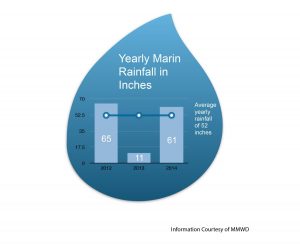The last highly impactful El Niño occurred in the 2004-05 winter season, when a large bout of rain caused flooding throughout the county.
According to Scott Lyle, the Principal Civil Engineer of the Marin County Flood Control District, another forceful El Niño is set to occur this winter, prompting flood control preparation in the Marin and the Ross Valley district.

“Right now we are doing our creek cleaning efforts,” Lyle said. “We’re using the conservation core to remove woody debris from the creeks and any overhanging branches and clearing those out of the way for major drainage ways.”
According to Lyle, the 2005 El Niño caused the Corte Madera and San Anselmo creeks to overflow, resulting in the flooding of many homes and business.
The Marin County Flood Control District has learned from past years to take greater measures that will lower the risk of flooding in the case of a large storm, according to Lyle.
“We used data basically to streamgage [a method for measuring the height of the water] a model of the entire watershed. From that model, we were able to simulate a storm and determine what kind of improvements are necessary in the valley to provide future flood protection,” Lyle said.
According to Lyle, the simulated storm helped indicate the various projects that would need to be put into action by the Marin County Flood Control District before this winter in the case that Marin faces floods that cause as much damage as they did in the 2004-05 winter.
“There are so many different microclimates that occur in the Ross Valley so you could have flooding anywhere depending on how the storm shell goes over it,” Lyle said.
The location of potential flooding depends on whether there are high tides or high flows. “High tides” refers to the rise of seawater and would affect areas that are near bodies of water, such as Larkspur. “High flows,” on the other hand, refers to the rise of channels, such as rivers and streams, and would affect areas that are next to creeks, such as San Anselmo.
While the Marin County Flood Control District fears that heavy rainfall could affect the creeks and areas near or at sea level, the Marin Municipal Water District (MMWD) hopes to get enough rain that the reservoirs completely fill.
Jack Gibson, a member of the MMWD Board of Directors, is one of many who hope for a rain-filled winter.
“We are in the water planning business,” Gibson said. “All of our plan is based on a two-year water supply, which is insufficient. I really think we need a broader plan that carries out for four years or five.”
Though a heavier-than-average supply of rain brought by El Niño would be the logical answer to California’s current drought, even an average rainfall of about 52 inches would benefit local reservoirs, according to Gibson.
MMWD relies on rainfall and the flow of the Russian River as its main water source. The stream of water that is expected to fill the reservoirs during the winter months will increase this year due to El Niño.
Krishna Kumar, general manager of the MMWD, sees the benefit of steady rainfall, but said that a high-impact storm like El Niño does not bring the same positive results.
“From the water management perspective, you want the rain to be slow and steady over a period of time,” Kumar said. “El Niño doesn’t give you that option.”
The reservoirs can only hold about 66 inches of water throughout the course of the year, and any excess water will overflow into the bay instead of getting transferred to other water districts, according to Gibson. Since Marin is located at the end of the Russian River, there would be nowhere for the water to go if any excess water were to overflow.


















